RIGHT TURN ONLY!!
Death and Rebirth
by Carlo Santos,

Eight years ago, I began writing this review column, sharing my thoughts on the growing selection of Japanese comics translated into English. As dozens of volumes of manga passed through my hands, I read and wrote about the ones I loved, the ones I hated, and the ones I didn't really care about either way. I discovered that some "fan favorite" and "critically acclaimed" hits weren't as great as everyone said they were; I desperately sang the praises of titles that were overlooked and underrated. I saw entire publishers go through boom and bust, an industry rise up and transform, while the fan culture changed along with it.
I got attached to dozens of characters, fell into the grip of countless worlds and storylines, and saw enough styles of art to fill the world's galleries. But through it all—the hits, the misses, the clashing opinions, the nods of agreement—I realized one thing: manga is an amazing artform. It can say so many things, and move people in so many ways. After experiencing all that, I'll now say this:
As of today, this is my last time writing Right Turn Only.
Thank you to everyone for reading, whether you were there eight years ago, or you just discovered this column the other week. It's been an honor to be one of the many voices on ANN. Whatever comes next, I know that this column—and the state of the fandom—will be in good hands.
BLOODY CROSS
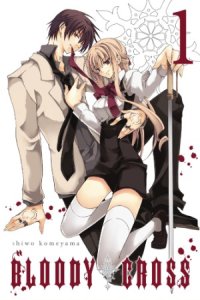
Vol. 1
(by Shiwo Komeyama, Yen Press, $11.99)
FROM THE BACK COVER:
"Half angel, half demon, Tsukimiya must drink pure demon blood to stave off the curse that will eventually claim her life. When she meets an angel named Hinata, he's eager to team up with the half-blood to take down a vampire that has been attacking humans. Tsukimiya is surprised to find that Hinata is a capable partner, but when the vampire is slain, it is Hinata who claims its demon blood, leaving Tsukimiya to be taken by the curse. In a last-ditch effort to save herself, Tsukimiya tries to drink Hinata's blood, now mixed with the vampire's pure demon blood. But in taking the blood that will save her, Tsukimiya has also transmitted the curse that will kill her. Hinata and Tsukimiya now share the curse...and they're running out of time."
EVIDENCE FOR:
Bloody Cross isn't afraid to cross genre borders: in this volume alone there's vampiric blood-sucking, epic angel-versus-demon warfare, and Eastern magic colliding with Christian mysticism. And if that's not intriguing enough, how about the characters themselves? Their hidden motives will keep everyone guessing about who's truly good or evil. The tension between Tsukimiya and Hinata is a taut thread that runs throughout the entire story: they double-cross each other in the first volume, but they need each other to survive ... thus making them both enemies and "friends." The trickery doesn't stop there, though: the ill-fated duo also gets into a battle of lies against a scheming angel, and other characters lurking in the shadows suggest that new foes could emerge from anywhere. Throw in the flirtatious banter between Tsukimiya and Hinata, and this series has plenty to keep fans occupied. The action scenes are slickly executed, with sweeping curves and dramatic angles bringing energy into each confrontation. The clean, delicate lines give the visuals a stylish touch, but there are also enough sprays of blood and ancient medieval ruins to invoke a feeling of grimness. Intricate religious imagery also adds to the cross-cultural flair.
EVIDENCE AGAINST:
Bloody Cross sets itself up as a brain-tickling cat-and-mouse game—but the problem is when the story starts chasing its own tail. By the middle chapters of this volume, Tsukimiya and Hinata's quest starts to look predictable and repetitive, falling into the dreaded "Go here, find the thing, defeat the villain" formula. Only the arrival of a brand-new character saves them from generic RPG grinding. The dialogue between the two main characters also starts running in circles, always returning to the "I'll pretend to work with you, but take all the magical power for myself" theme that was already expressed at the very start. At some point, that contentious relationship needs to develop (whether positively or negatively) if the story is to ever move forward. The frenzied fight scenes, impressive as they are, have weaknesses as well—some panels are nothing but visual filler, crammed with wild explosions and sacred beams of light. What's more, the lack of screentones makes it hard to tell between the characters, foreground details, and backgrounds. Then again, the bland character designs are also partly to blame for the lack of clarity and contrast.
FINAL VERDICT:
This one does run into some supernatural-action clichés, but the guessing game behind the characters' motives, along with stylish artwork, still make it worthy of a B-.
KNIGHTS OF SIDONIA
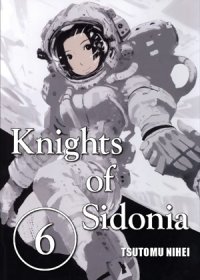
Vol. 6
(by Tsutomu Nihei, Vertical, $12.95)
FROM THE BACK COVER:
"While innovations including the GC-Piercing Discarding Sabot improve the seed ship Sidonia and her mobile units' odds, for humanity to secure a definitive edge against foes as rapidly adaptive as the Gauna the physical sciences may not suffice."
EVIDENCE FOR:
Knights of Sidonia gets the balance just right in this volume: intense human-versus-alien battles in the opening and closing chapters, with some vital plot developments in the middle. Ace pilot Tanikaze's adventures are sure to get pulses racing in the first chapter, especially as he uses a last-resort weapon to eke out a victory. What's more, the unique aesthetic—where intergalactic bio-horror meets giant-robot flair—makes it stand out. Next come the unsettling revelations in the middle: skulking scientists and creepy experiments that make one wonder who the real monsters are. It all leads up to the next battle, where Tanikaze crosses paths with a new-and-improved Gauna, and an unexpected intrusion sets up the perfect cliffhanger. Somehow, the story even sneaks in some comedy moments, helping to break the mood before it ever gets too dour. Nihei's artwork is toned down from his usual hyper-detailed style, but the personal touch is still there: the bubbling, creepy-crawliness of the Gauna, the angular features of the Garde robots, and the gloomy shadows of space. Action scenes are the visual highlight as always, but the sprawling biodome scenery aboard the Sidonia also has its charm.
EVIDENCE AGAINST:
Before the first scene is even over, Knights of Sidonia already has problems: the robot pilots and the starship crew are yelling things that barely make sense. Yes, it's the dreaded onslaught of technical jargon, which adds to the sci-fi ambience but doesn't say much about what's going on. There are times when the visuals have the same issue: they may look impressive on the page, but it's hard to tell which alien part or robot component just got hit, or even figure out which side is winning the fight. Both the first- and last-chapter battles are guilty of this, dotting the page with laser beams and debris that hinder more than they help. The quieter, space-station moments aren't immune to criticism either: some of the attempts at humor (and even romance) are just plain dumb, relying on tired school-comedy clichés. Maybe it's "funny" to put them in a place as unlikely as a dystopian space adventure, but the situations any lack real creativity. The plain, blank-eyed character designs also make it hard to read people's expressions during these down-to-earth, human moments.
FINAL VERDICT:
Although the story and art lack clarity in some places, the overall product still packs enough action and dramatic events for a B.
NO. 6

Vol. 4
(by Atsuko Asano and Hinoki Kino, Kodansha Comics, $10.99)
FROM THE BACK COVER:
"Shion accidentally learns that his childhood friend Safu is under arrest—and all because of him! Not wanting to get Rat involved, Shion sets out alone to save her. But how can he possibly infiltrate No. 6's secure correctional facility and escape with a high-priority prisoner all on his own?"
EVIDENCE FOR:
Volume 4 of No. 6 has it! It's got ... the kiss. But the tantalizing chemistry between Rat and Shion—one the stoic protector, the other a wide-eyed idealist—is just one of its many strong points. In this volume, it seems everyone is a wannabe hero, wanting to sneak bravely into No. 6 despite their friends' warnings. Sometimes this leads to thrilling, violent confrontations, like Rat's tiff with Dogkeeper; other times it leads to hot-tempered arguments where intense feelings come pouring out, like with Rat and Shion. The drama picks up even more when everyone bands together and agrees on a plan, one that involves illegal acts (kidnapping and torture) to fight against even worse injustices (Safu's imprisonment and apparent "erasure"). Once again, the series raises that question about who is morally right when everyone's a wrongdoer. Along the way, Hinoki Kino's art has improved as well—the linework looks dynamic and confident, no matter whether the characters are caught up in a physical battle or yelling at each other across the room. Deep shadows and frequent use of nighttime or indoor settings also match the mood of the story as it grows darker.
EVIDENCE AGAINST:
When they say the main character is going to try to sneak into the evil oppressive city, shouldn't he actually ... sneak in at some point? This volume is a collection of false starts and stops, where everyone plans on infiltrating No. 6 but they never actually do. At least the protgaonists gather some information about the correctional facility, with hints about the super-secret plot going on there—but leaving the payoff until the next volume is rather unsatisfying. The on-again, off-again relationship between Rat and Shion can also make it feel like their side of the story is going in circles: every time something happens to bring them closer, they get into another disagreement ("I want to protect you!" "But I want to do something for myself!") that lands the pair back at square one. The fact that this volume is mostly about arguing and planning also means that the artwork doesn't reach its full potential: we get too many conversations and not enough striking views of far-future dystopia. Chaotic layouts—where different viewpoints and characters are all crammed onto one page—also make some scenes hard to follow.
FINAL VERDICT:
Although it doesn't quite deliver all the action it promises, there's enough tension and drama (with at least some action sprinkled in) to earn this volume a B.
PSYREN
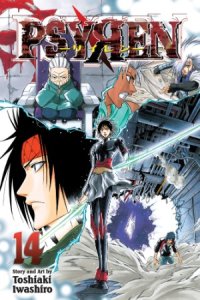
Vol. 14
(by Toshiaki Iwashiro, Viz Media, $9.99)
FROM THE BACK COVER:
"Ageha Yoshina just got transported to a warped alternate dimension where you've got to fight your way back to our world—or die trying.
W.I.S.E.'s elite battle force, nicknamed the 'Scourge,' is attacking the Root! After a fierce battle, Ageha, his fellow Psionists and the Elmore Wood Gang succeed in driving them away. But when Star Commander Junas shows up, Ageha finds himself driven into a corner..."
EVIDENCE FOR:
One of the great things about a psionic battle series is being able to make up any special power as long as it's consistent with the story. This volume of Psyren takes that idea as far as it can go, revealing a fresh slate of brand-new abilities. Some are designed to impress, like a giant fire demon, and others are just plain clever, like the fear of getting hurt being turned into an evasive, time-manipulation tactic. Then comes the biggest surprise of all: Ageha, the ostensible hero, doesn't unveil a killer move, but has to get bailed out by an unexpected ally, and discovers entire fields of psionic combat he hasn't heard of. A tragic shock and new developments in the later chapters also set up a bigger, more explosive story arc to come. The artwork comes with all the fancy special effects and dynamic poses one would expect from a no-holds-barred battle, with particular emphasis on size (every blast fills an entire room) and speed (everything happens within seconds). Every character has a unique look—always important in a big melee—and well-organized page layouts allow the story to move forward smoothly.
EVIDENCE AGAINST:
This volume of Psyren is action done wrong: too big, too messy, and too focused on one-on-one combat. There's an entire team of heroes and an entire team of villains all locked into separate battles, so the only way to tell the story is to flip-flop between multiple fights for several chapters—a technique that soon becomes tiresome. Meanwhile, the roster of fighters includes side characters that readers have barely heard of, so it's hard to take an interest in their powers and their motivation for fighting. Then again, a lot of the villains express their motivation as "I'm really evil and I'm going to beat you into the ground," so it's not like they had anything important to say anyway. Why come up with such fascinating costumes and powers and waste them on poorly-developed personalities? The nonstop battles also mean that the even the artwork stops being impressive after a while—when every other page involves an explosion, time-shifting dimensional pockets, or superhuman feats of strength, then nothing looks amazing anymore. To use a metaphor, you can't appreciate the "loud" moments when the volume is always turned up to 11.
FINAL VERDICT:
It's easy to be wowed by the stylish art and psionic powers, but it's just as easy to get bored when that's the only thing going on—which is why this volume gets a C.
SUNSHINE SKETCH

Vol. 7
(by Ume Aoki, Yen Press, $11.99)
FROM THE BACK COVER:
"With Sae and Hiro staring their college entrance exams straight in the face, the underclassmen of Hidamari Apartments are reminded that their own graduation is just a short time away…but there's still plenty of time for the girls to make fun memories in the meanwhile!"
EVIDENCE FOR:
Sunshine Sketch hits the "golden age" in Volume 7—that time when the main characters are in the prime of their high school years, and really digging into the joy of school festivals, holidays, and final exams. These events lead to all sorts of humor: the girls trying to devise the scariest haunted house, inviting friends over for Christmas and having a wacky present-exchange routine, and stressing out over finals (and for the seniors, college applications) in strange ways. But day-to-day life has comedy potential as well, like when we hear of an art student's worst nightmare (not saving in Photoshop!), or the struggle of trying to impress one's parents when they come to visit. Some heartwarming moments also sneak their way into this volume—most notably Sae and her sister discussing their goals for the future. Surprisingly, the artwork shows lots of variation within the four-panel format: the characters shift between "normal" and super-deformed style, they bust out with goofy faces and visual gags, and the backgrounds alternate between standard dorm/classroom interiors, stylized patterns, and blank space. See? Four-panel strips don't have to be repetitive as long as there's creative effort.
EVIDENCE AGAINST:
Even with all the artistic variety and amusing situations, Sunshine Sketch still has its limits. Practically everything happens within the Hidamari Apartments themselves—there are barely any scenarios where the girls are in class, or socializing in school hallways, even though those would be great places for comedy. (The one major exception is the school festival.) Other times, the series simply prattles on without delivering any punchlines, hoping that the characters' inherent cuteness will carry it through these dry spells. For example, when we learn that Nazuna is terrible at cooking ... well, that's a character trait, but it's not an actual joke. Veterans of this genre may also be tired of seeing the same pattern again and again: just once, can we enjoy the foibles of school life without having to run the beach-festival-Christmas gauntlet? Ume Aoki's limitations as an artist also become clear when multiple characters show up in one scene; everyone has the exact same face shape and body type (even fully grown adults). Furthermore, the way the dialogue is laid out—always along the sides of each panel—makes for monotonous reading.
FINAL VERDICT:
It has moments of genuine humor and heart, but as with any four-panel slice-of-life, the scattered plot and simple artwork knock it down to a C+.

CYBORG 009
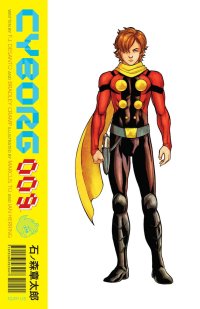
(story by F.J. DeSanto and Bradley Cramp, art by Marcus To and Ian Herring, concept by Shotaro Ishinomori, Archaia, $24.95)
FROM THE BACK COVER:
"Awakening in a futuristic military installation with no memory of who he is or how he got there, a young man known only as Cyborg 009 has been stripped by his captors of not only his freedom but also his humanity. His body augmented by cybernetic technology, Cyborg 009 joins forces with 8 other men and women, Cyborgs 001-008, setting off on a journey to learn the truth of his creation and prevent a global conflict that could engulf all of humanity."
EVIDENCE FOR:
Now here's an inversion from what we usually see in this section: a Westernized adaptation of a Japanese manga. Archaia's take on Cyborg 009 is polished in all the ways 21st-century audiences will love—stylish, attractive characters, flashy displays of technology, and fight scenes that combine the bombast of "superhero style" with the kinetic, moment-to-moment pacing of "manga style." The vibrant, full-color pages also add life to the art. But for all its modern trappings, the updated Cyborg 009 is still true to its roots, telling a universal tale of human goodness versus human greed. A likeable cast of characters certainly helps its cause—you'd think it would be hard to learn all the members of a nine-person superhero team, but when they have such distinct powers and personalities, it's a piece of cake. Along the way, the story also delves into the personal lives of the characters, like a father desperate to save his infant son, or a young man facing the challenges of leaving his old life behind. Subplots like these are a reminder that the path of good triumphing over evil is rarely a straight one—and that's what makes this adventure fun.
EVIDENCE AGAINST:
The graphic novel's head writer, F.J. DeSanto, is also working on a live-action film version of Cyborg 009—and it shows. The plot is as predictably "Hollywood" as they come, with the heroes being shuttled from one prefabricated set-piece to the next. There's the explosive origin story, the hero's crisis of conscience, the initial confrontation with lower-level villains, and finally some technological mumbo-jumbo leading up to a melee with the big bad boss at the end. It may be a thrilling piece of eye candy, but we've all been down this path before, and there's not even a surprise twist or secret character waiting to jump out and turn the story around. The nuances of morality—heroes sometimes lose their way, and bad guys sometimes turn out to be do-gooders—get lost in the hyperactive pacing, where rushing to the next action scene is more important than thoughtful ideas. This also affects the artwork, which seems to fill every other page with fancy heroic poses, and rarely slows down for establishing shots or reflective moments. Instead, every panel has to have something going on, thus leaning a little too close to the visual excesses of American comics.
FINAL VERDICT:
The style and era is wildly different from the original, but the spirit of cyborg heroes fighting against injustice is still there—and in a very visually appealing format.
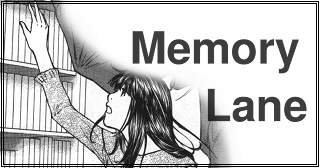
LOVE ROMA
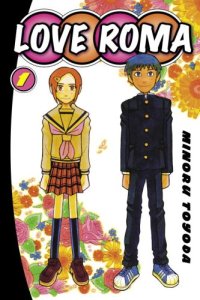
(by Minoru Toyoda, Del Rey)
It sounds like a trite thing to say, but it's true: Love Roma is the school romance for people who are tired of school romances. (Which is why it's a shame that finding copies is getting harder and harder...) The series flips the traditional script and has the main characters confessing their love right in the very first chapter, rather than spending countless story arcs dancing around the issue. Hajime Hoshino, an overly earnest high school boy, admits his feelings to kind-hearted Yumiko Negishi right in front of their entire class—and so begins a five-volume saga on how to have a sweet, honest relationship, instead of all the drama, miscommunication, and backstabbing that is often unfairly associated with the genre.
The lack of pretensions is part of the magic in Love Roma: Hoshino and Negishi simply work their way up the romantic ladder, going on dates, participating in school activities, and—at least once or twice per volume—sharing some irrepressibly cute "Awww" moments together. Everyone else can have their love polygons, fanservice comedies, supernatural twists, and whatnot: this one reminds us that the simplicity of two kids falling in love is a worthy story all on its own. However, it does take a weird turn at the end, with Hoshino and Negishi suddenly becoming super-serious about their relationship ... but despite this unexpected shift in tone, but the story's generally sweet sentiment remains.
Even the artwork stands out from the norm—bold lines and stylized character designs give the visuals a distinctly flat, maybe even unrealistic, appearance. But in a series that's all about idealized romance, an "idealized" art style just makes sense, doesn't it? The story is also helped along by simple, straightforward page layouts, which reflect Love Roma's central theme: that honesty is the best policy, and if you want to succeed in life, just say what you mean.
discuss this in the forum (27 posts) |